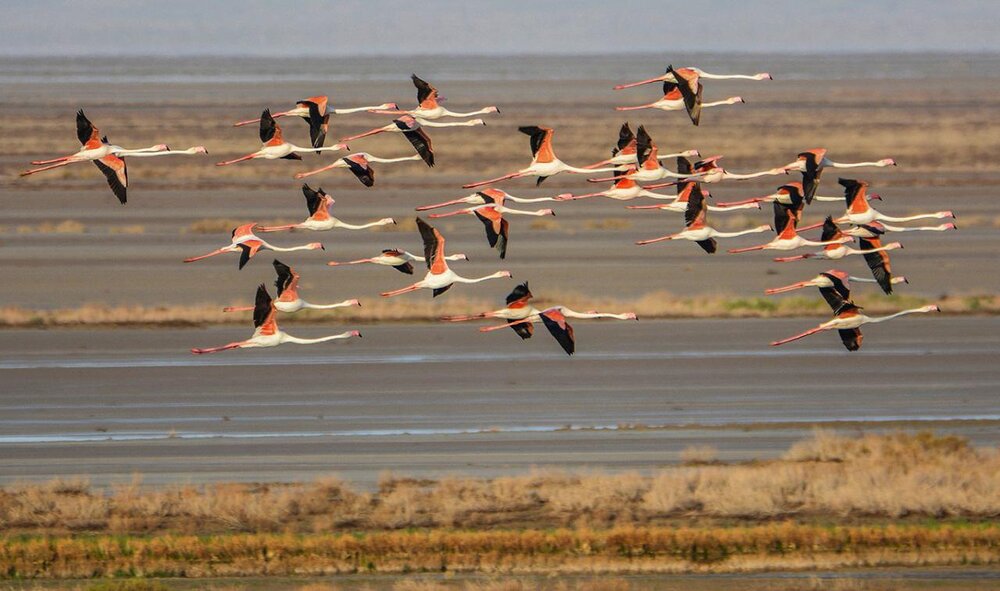TEHRAN – Gavkhuni wetland in the central province of Isfahan, which was replenished last year, is hosting hundreds of flamingos for the second year after years of dryness, IRNA reported on Sunday.
Stretching to 47,000 hectares, Gavkhuni is a salt marsh with an average depth of about 1 m. which is located on the terminal basin of the Zayandeh-rud river.
It is the 19th wetland in Iran designated as a Wetland of International Importance on Ramsar list, which as defined by the Ramsar Convention for the conservation and sustainable use of wetlands, recognizes the fundamental ecological functions of wetlands and their economic, cultural, scientific, and recreational value.
The Convention was adopted in the Iranian northern city of Ramsar in 1971 and came into force in 1975.
It was in April last year that images of flamingos were published in the Gavkhuni International Wetland, which revealed that these migratory birds landed in the habitat again after two years of absence, and this year, a video of their presence in the wetland was released, raising hope for all kinds of migratory birds to return.
Gavkhuni wetland, which is considered to be home to various species of migratory birds in the east of Isfahan province, has been facing water scarcity and declining water levels over the past decade, with recent surveys showing that the number of migratory birds in the wetland has declined significantly.
Hossein Akbari, the provincial department of environment deputy director confirming the presence of 100 flamingos in Gavkhuni Wetland, said that these birds have been observed in the northern part of the wetland where the Zayandeh-rud river flows into the wetland, and more may be found in other parts of it.”
In previous years, before the wetland dried up, numerous flamingos came to this place, for instance in [the Iranian calendar year] 1386 (March 2007 – March 2008), thousands of flamingos were observed in this habitat, he noted.
Besides flamingos, the wetland is now home to a variety of migratory birds including, ducks, geese, sternidae, pelicans, and grebes, he added.
The migratory birds are now migrating from the northern and cold regions to the south, and the more water the wetland receives, the longer the migratory birds will stay, he highlighted.
He went on to say that drainage and lack of nutrition prevent migratory birds to turn back to the wetland “so that we are seriously pursuing the issue to provide the water right of it and witness water flow into the lakebed.”
The water right of the wetland is about 176 million cubic meters per year.
Recent observations show that about 21 percent of Gavkhuni wetland is wet, and about 41 million cubic meters of water entered the wetland in the second half of last year, which is 23 percent of the wetland's minimum annual water needs to maintain its ecological function.
Since it has been deprived of receiving water rights for many years and even reached a complete drought two years ago, the water released last year has penetrated more into its lower layers.
Last winter, about 355 migratory birds of 9 species were counted in this wetland, which demonstrates a great reduction compared to three years ago when 2,151 aquatic birds of 31 species were counted in the area.
The number of migratory birds in the winter, when the Gavkhuni wetland was full of water and normal, averaged 20,000 and even reached 150,000 in the early 1370s (falling on 1991-2001).
Based on the latest data published on Friday by National Drought Warning and Monitoring Center affiliated to Iran’s Meteorological Organization, precipitation in the country increased to 263.5 from 201.7 millimeters (mm) of the long-term average, demonstrating a 30.7 percent raise.
Isfahan province also surpassed the long-term precipitation amount of 141.5 mm, as 145.8 mm poured over the province.
TAGS


No comments:
Post a Comment